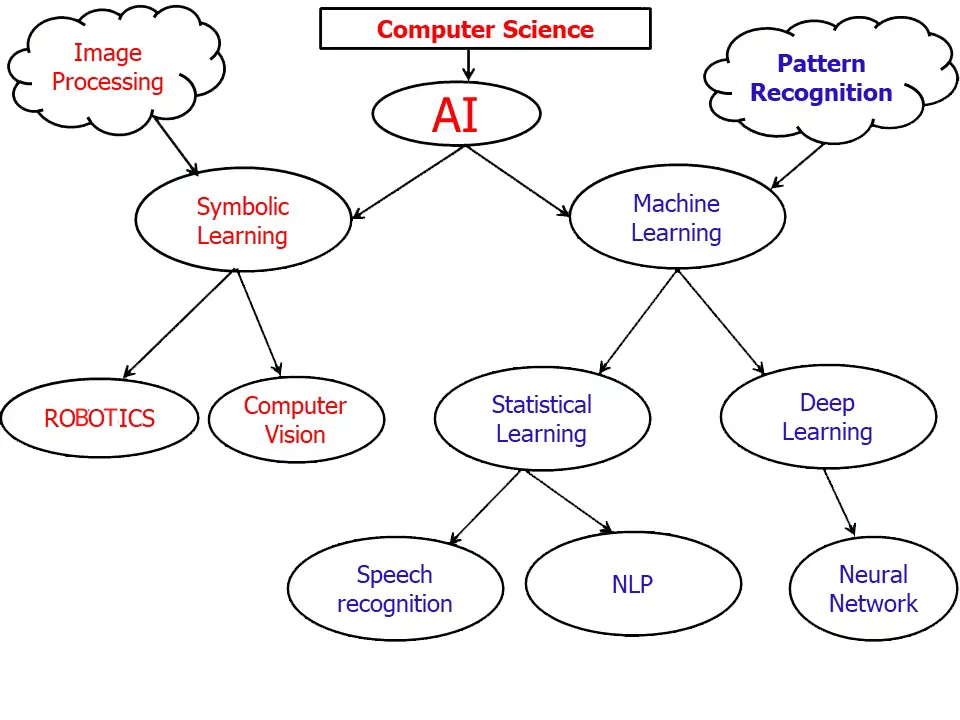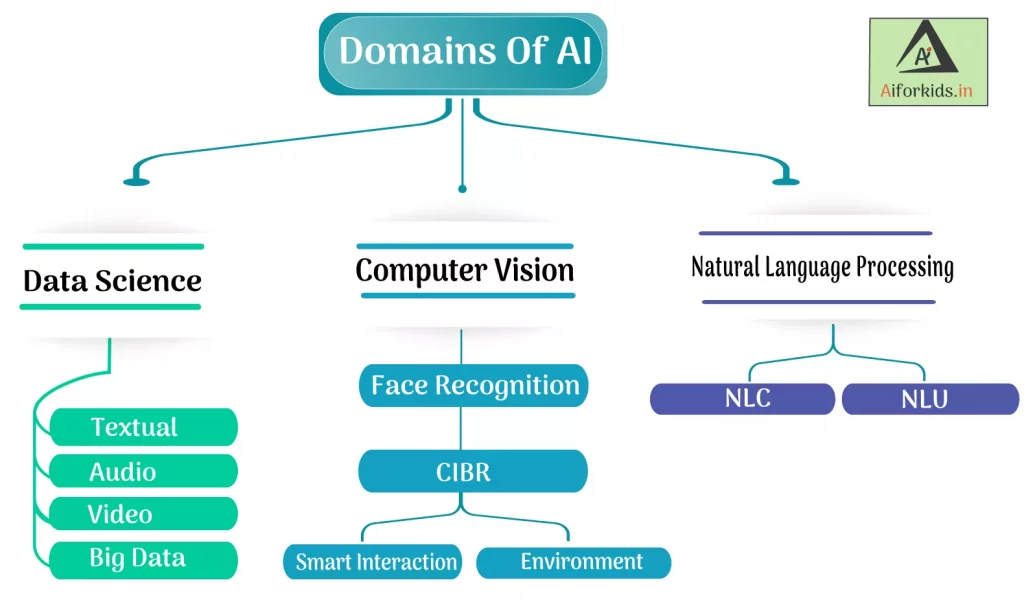How AI Is Empowering Smart Learning for Young Minds?
From adaptive learning platforms to individual strengths and weaknesses to intelligent tutoring systems the possibilities provided by AI for young minds are abundant. We will see today how it is empowering youth and transforming the learning ways.
What is Artificial Intelligence and its Role in Education?
Artificial Intelligence refers to the simulation of human intelligence in machines that are programmed to think, learn, and perform tasks independently.
AI is not just a single piece working alone, its a combination of lots of amazing stuff put together to make this technology possible, It encompasses various tools that feature machine learning, natural language processing, and computer vision, enabling them to process data, recognize patterns, and make decisions or predictions.

3 Domains of AI
In Brief, Artificial Intelligence is divided into 3 domains of AI:-
- Natural Language Processing (Mouth of AI)
- Data Science (Brain of AI)
- Computer Vision (Eyes of AI)

Applications of AI

One of the most widely used AI tools is Essay Rewriter. It has made preparing lengthy and time-taking tasks easier and fast, providing students with versatile opportunities for educational objectives.
These systems can analyze vast amounts of data and provide real-time feedback, enabling students to track their progress and identify areas that require improvement.
5 Ways AI Is Empowering Smart Learning for Young Minds
- Personalized Education
It is revolutionizing education by enabling personalized learning experiences for students. AI-powered systems can analyze individual learning patterns, preferences, and strengths, allowing educators to tailor instructional content and pace to meet the specific needs of each student.
Providing personalized feedback and adaptive assessments, AI is helping students progress at their own pace, ensuring a more efficient and effective learning journey.
- AI Content Creation
AI tools can generate educational content that is interactive, engaging, and tailored to specific learning objectives. These are equipped with different writing tones and modes to suit the varying needs of the students.
- Information visualization: The use of visual elements such as charts, graphs, and diagrams to represent complex data or concepts in a more accessible and easily understandable format, aiding in knowledge comprehension and retention.
- Rewriting the existing content: Online Article Spinner that are free to use, faster, equipped with different paraphrasing modes, and authentic have made rephrasing the existing content easier for content creators. The rewritten content is free of plagiarism, and grammar errors, readable, and a better version of the previous one.
- Digital lessons: Educational materials and resources that are delivered electronically, providing an interactive and engaging learning experience through the use of multimedia elements, interactive activities, and online platforms.
- Learning content updates: Refer to the continuous process of revising and updating educational materials to ensure accuracy, relevance, and alignment with the latest information, and advancements, by keeping in view the curriculum standards.
These tools assist in creating immersive simulations, virtual reality experiences, and interactive quizzes, enhancing student engagement and knowledge retention. Through artificially-generated content, students can access a diverse range of learning materials that cater to their learning styles and interests.
- Task Automation
AI’s ability to automate routine administrative tasks allows educators to focus more on personalized instruction and student support.
By Streamlining the tasks such as grading assignments, generating progress reports, and managing administrative workflows, the students will be able to free up their valuable time for educators to dedicate to meaningful interactions with students.
This automation not only increases efficiency but also reduces the burden on teachers, enabling them to provide better support to young minds.
- Individual Tutoring Outside Classrooms
AI-powered virtual tutors and educational chatbots are revolutionizing individual tutoring experiences for students. These tools provide personalized guidance, instant feedback, and additional support outside the classroom.
Virtual tutors can adapt their teaching style and pace based on a student’s individual needs, providing targeted assistance and facilitating independent learning. This personalized tutoring helps students reinforce their understanding of concepts and develop their problem-solving skills.
- E-Learning Opportunity for Students with Special Needs
The utilization of innovative artificial technologies creates fresh avenues for engagement among students with learning disabilities. It facilitates educational access for those who are deaf or hard of hearing, visually impaired, or have Autism Spectrum Disorder (ASD).
It has opened up new opportunities for e-learning, tailored support, adaptive learning paths, and assistive technologies to accommodate different learning styles and abilities.
Source: Piogroup.net
From speech recognition and text-to-speech tools to customized learning interfaces, it enables students with special needs to access educational resources and participate in the learning process on an equal footing with their peers.
Pros and Cons of AI in the Education Sector
Artificial Intelligence has made significant strides in transforming the education sector, revolutionizing the way we teach and learn.
However, like any technology, it comes with its own set of advantages and disadvantages. Let’s explore the pros and cons of AI in the education sector, shedding light on the potential benefits as well as the challenges that arise.
Pros of AI in the Education Sector:
- Individualized Learning:
It enables personalized learning experiences, adapting to individual student needs, preferences, and pace, fostering a more efficient and effective learning journey.
- Enhanced Student Engagement:
AI-powered tools and platforms offer interactive and immersive learning experiences, leveraging technologies such as virtual reality and gamification, making learning more engaging and enjoyable for students.
- Data-Driven Insights:
With the use of AI tools large volumes of data provide educators with valuable insights into student performance, learning patterns, and areas of improvement, enabling targeted interventions and instructional adjustments.
- Efficient Administrative Tasks:
Artificial intelligence automates administrative tasks, such as grading, generating reports, and managing workflows, reducing administrative burdens on teachers and freeing up time for more meaningful interactions with students.
- Accessibility and Inclusion:
It facilitates inclusive education by providing support and accommodations for students with special needs, allowing them to access educational resources and participate in the learning process on an equal footing.
Cons of AI in the Education Sector:
Artificial intelligence (AI) is a powerful tool that can enhance learning and teaching in many ways. However, it also has some drawbacks that need to be considered. Here are some of the cons of AI in the education sector:
- High cost: AI requires a lot of investment in terms of installation, maintenance and repair. Not all schools and students have access to the technology and resources needed to use AI effectively.
- Overreliance on technology: AI may reduce the need for human interaction and guidance in the classroom. Students may become dependent on AI and lose their critical and creative thinking skills.
- Lack of emotional intelligence: AI cannot understand or respond to human emotions and feelings. Students may miss out on the social and emotional aspects of learning that are essential for their development and well-being.
- Communication barriers: AI may not be able to communicate effectively with students from different backgrounds, cultures and languages. Students may face difficulties in understanding and expressing themselves with AI.
- Maintenance problems: AI may malfunction or break down at any time, disrupting the learning process and causing frustration and inconvenience for students and teachers.
Final Verdict:
The empowering role of AI in smart learning for young minds is undeniable. Through personalized education, smart content creation, task automation, individual tutoring, and e-learning opportunities for students with special needs, AI has revolutionized the education sector.
With AI as a transformative tool, we have the opportunity to unlock the full potential of young minds, fostering critical thinking, and creativity, in the digital age.
Thankyou for Reading this article, Any Suggestions/feedbacks can be mailed to care@aiforkids.in
Ceo Aiforkids

